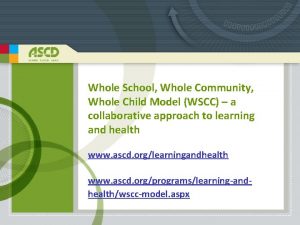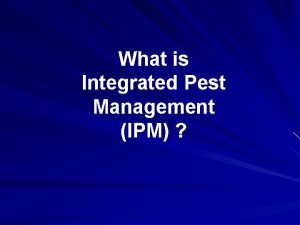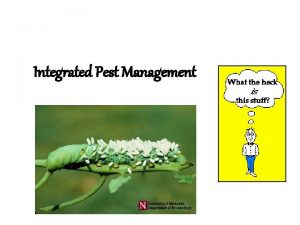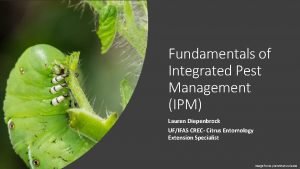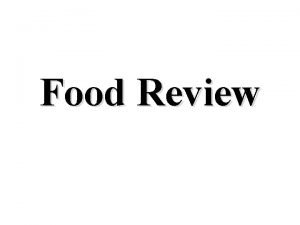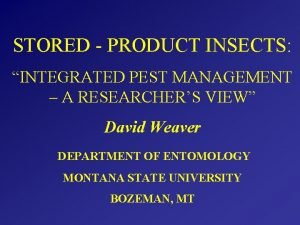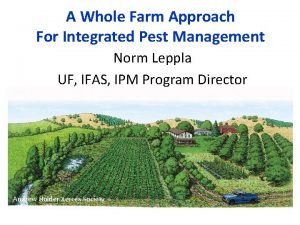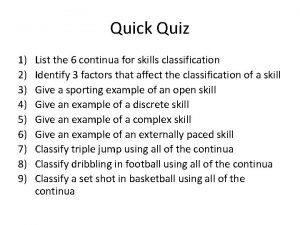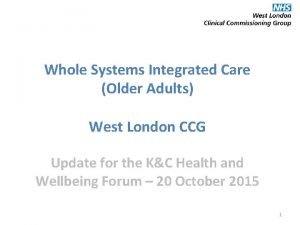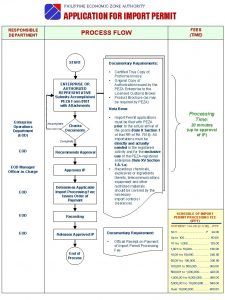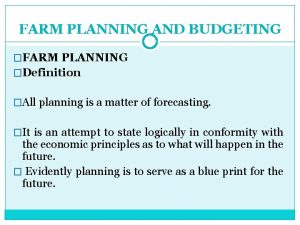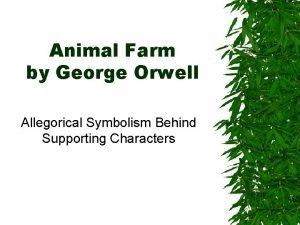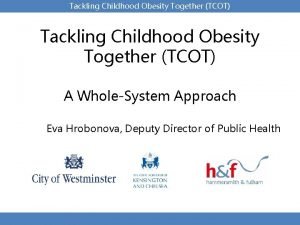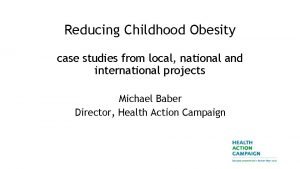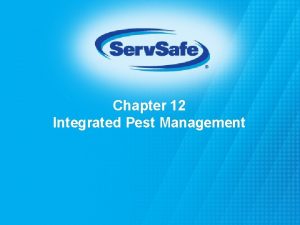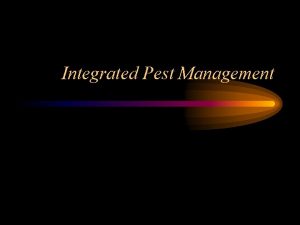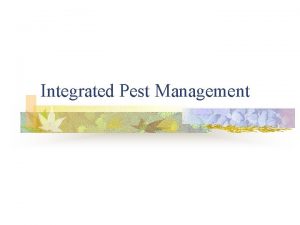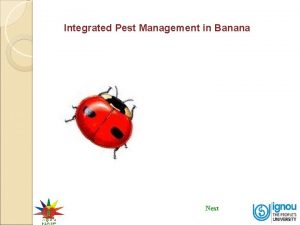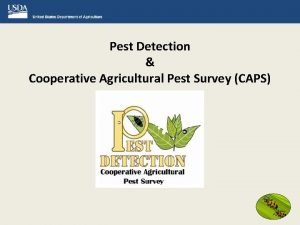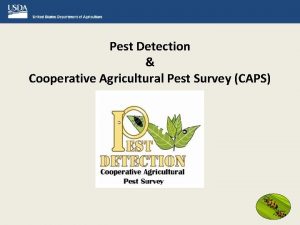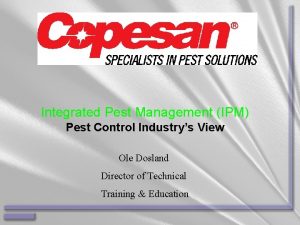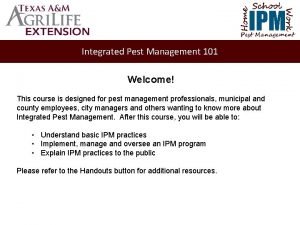A Whole Farm Approach For Integrated Pest Management














- Slides: 14

A Whole Farm Approach For Integrated Pest Management Norm Leppla UF, IFAS, IPM Program Director Andrew Holder Xerces Society

FLORIDA EXTENSION INITIATIVE 1: INCREASING THE SUSTAINABILITY, PROFITABILITY, AND COMPETITIVENESS OF AGRICULTURAL AND HORTICULTURAL ENTERPRISES STATEWIDE EDUCATIONAL PROGRAMS for “Sustainability of Production Systems and Alternatives” Sub-action plans: • • Food Systems and Food Security Animal Systems Plant Systems Integrated Pest Management (IPM)

Integrated Pest Management (IPM) Pest diagnostics and management. Develop and implement improved methods for detecting, identifying, reporting, and managing invasive species (insects and other arthropods, pathogens, weeds and other pests). IPM systems. Develop IPM systems for entire sites, e. g. , farms and ranches, neighborhoods, municipalities, etc. , that increase adoption of intelligent pest management strategies. Education and training. Increase the adoption of IPM practices by Florida farmers and ranchers, property and municipal managers, and others by expanding delivery of the required education and training.

SUPER ISSUES 1. Enhance the Statewide IPM Program (IPM Florida) to adequately address critical needs and significantly increase the awareness, appreciation and adoption of IPM options for protecting food systems and the environment. 2. Realize the potential for IPM to enhance resource sustainability and conservation in Florida communities. 3. Increase collaboration between state specialists and county Extension faculty.

Crop ecology Biologically diversified farming systems Landscape ecology Farmscaping: Making Use of Nature’s Pest Management Services Holistic approach to farming Geoff Zehnder, IPM Coordinator, Clemson University Sustainable agriculture Farmscaping is a whole-farm, ecological approach to increase and manage biodiversity with the goal of increasing the presence of beneficial organisms. Agroecology Ecoagriculture

Farmscape Planning Ø Keep good records of where, when, and what pests Ø Ø Ø occur on the farm. Gather information about key pest and natural enemy life cycles and habitat requirements. Make a list of available strategies that can be implemented to create a habitat for the beneficials (insectary plants), and a more unfriendly habitat for pests (trap crops). Select a combination of strategies that best fit your farm plan (i. e. , location of your fields, crops grown and rotation plans, available equipment and labor). Choose appropriate annual and perennial insectary plants. Observe and keep records of the results; experiment with different strategies and fine tune the system. Start simple and small, then develop and expand the farmscape based on observations and results. Lettuce, cabbage & sunflower Alfalfa and strawberries, Sean Swezey, U. California

Ø The application of ecology to the design and management of sustainable agroecosystems. Ø A whole-systems approach to agriculture and food systems development based on traditional knowledge, alternative agriculture, and local food system experiences. Ø Linking ecology, culture, economics, and society to sustain agricultural production, healthy environments, and viable food and farming communities. Ecology is the scientific study of interactions among organisms and their environment

Sustainability of Agriculture Economic profitability Environmental resources & health Social and economic well-being

Holistic Approach to Farming Social Political & Regulatory Environment Physical & Biological Environment Crop Ecology & Management Market Soil Health Farm Size, Labor, Capital Debt, Land Materials Containment • Soil • Residues • Nutrients • Pesticides Whole Farm Integrated Pest Management Landscape Ecology Efficiencies & Cost of Production Return R. R. Harwood Michigan State University Extension

What is IPM? It coordinates the use of pest biology, environmental information, and available technology to prevent unacceptable levels of pest damage by the most economical means, while posing the least possible risk to people, property, resources, and the environment.

Generic IPM Program Ø Biological knowledge Ø Monitoring and inspection Ø Act to control pests when necessary Ø Choose least-risk options Ø Long-term, preventative practices Ø Evaluation and records Ø Pesticide management Ø Continual improvement

IPM System • • • INCREASE… Pest outbreaks & disease epidemics • Reliability Environmental contamination Human health hazards Pest mgmt. costs • Sustainability Chem Biological Control Reduce risks Cultural Methods

Farmscaping- A Whole Farm Approach For Integrated Pest Management Ø What is Farmscaping and Whole Farm IPM? Ø Developing a Year Round Habitat of “Plants with a Purpose” Ø Protecting and Enhancing Honeybees and Native Pollinators Ø Vertebrate Predators (Birds, Bats, and Owls) Ø Specific Management Strategies Ø Trolley Tour of the Center’s “Farmscape” Ø Monitoring and Scouting for Vegetable Crops Ø Good Bug, Bad Bug Identification Hands-on Microscope Activity Ø Cover Crops, Agronomic Crop IPM Practices and Whole Farm Weed Management Strategies Ø Putting it all Together

http: //ipm. ifas. ufl. edu Buel P. Colton 1907
 Whole school whole community whole child model
Whole school whole community whole child model Pest management learning
Pest management learning Integrated pest management
Integrated pest management Ipm
Ipm Integrated pest management ____ than pesticides
Integrated pest management ____ than pesticides What is the third step in integrated pest management?
What is the third step in integrated pest management? Whole farm approach
Whole farm approach Whole part whole practice
Whole part whole practice St charles integrated care centre
St charles integrated care centre Peza import permit procedure
Peza import permit procedure Steps in farm planning
Steps in farm planning What was the problem with the farm tools in animal farm
What was the problem with the farm tools in animal farm Pinchfield farm
Pinchfield farm Whole system approach to obesity
Whole system approach to obesity Whole system approach to obesity
Whole system approach to obesity
